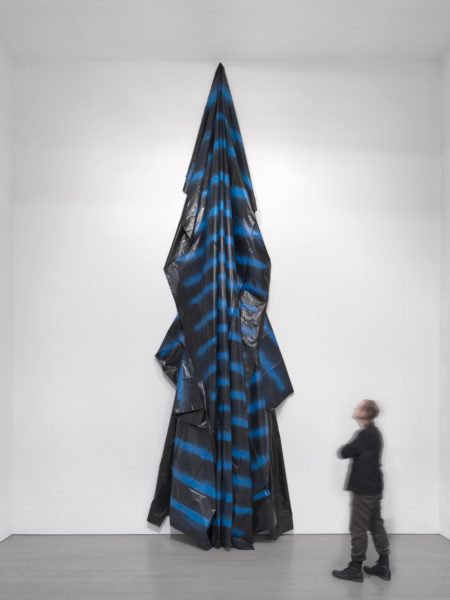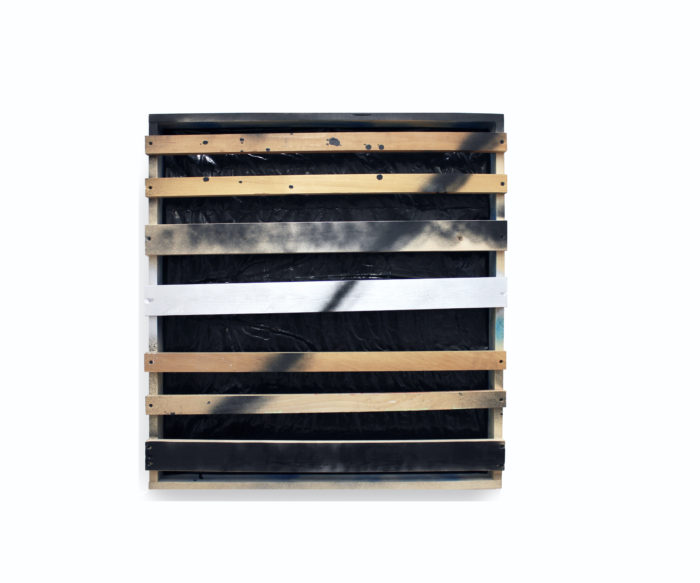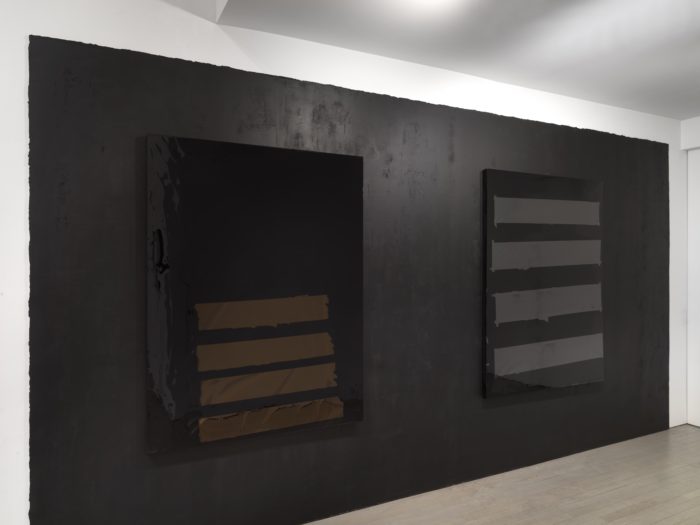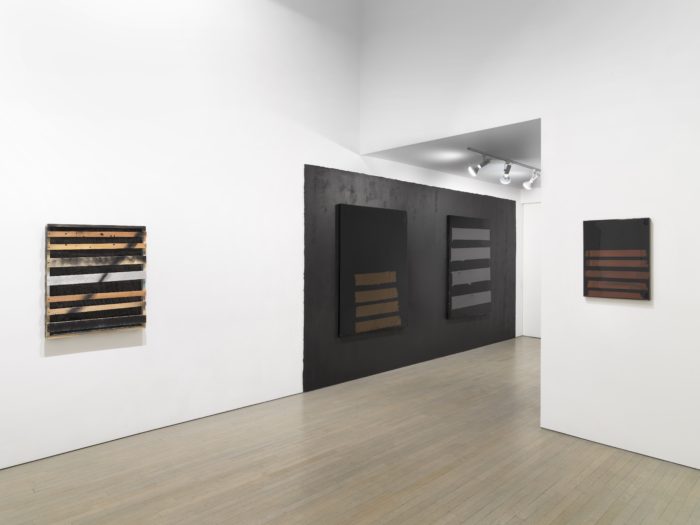
New York-based artist Tariku Shiferaw, born in Addis Ababa, Ethiopia, and raised in Los Angeles, just opened his solo exhibition in Carroll Gardens at Cathouse Proper @ 524 Projects. His remarkable show is small–less than ten works of art–but it throws unusual light on current developments in painting in both a formal sense, as a continuation of New York School visual insights, and in a social sense, as a young black painter. The circumstances Tariku is addressing are available from the very beginning of the show. On entering the second-floor gallery in south Brooklyn, visitors come across a group of hooded jackets, with horizontal lines of acrylic paint worked onto the front of the sweatshirts. While the clothing makes only a modest visual statement, its social projection, as an assertion of self, is loud and clear.
Shiferaw wears these articles of clothing, so they are more than mere stand-ins for him as a person; they belong to his body as a black man–hoodies have been part of hip-hop culture for decades. Additionally, the artist names all of his works, including the sweatshirts, with titles taken from various songs belonging to black music–hip hop, r&b, rap, reggae. By using these titles, the artist immediately invests his works of art with a legacy that is at the same time highly contemporary. Often the meaning generated within the songs affect Shiferaw’s artworks themselves–in the sense of the meaning they carry–although this is not directly evident in the artwork.

Shiferaw has made it clear in conversation that his work, however abstract it may be, is intended to be a statement made by a person making marks in a milieu in which he often feels himself to be misunderstood. As a result, Shiferaw is establishing his own milieu–to support and protect himself, physically and metaphysically, within the context of his work. Doing so allows him to be himself–a state difficult to achieve in the world of the New York School, which his art deliberately references. It must be said, then, that the paintings, which are remarkably taut works of art, are also signs of a presence, as an artist of color, that within living memory was seen as an anomaly within the artworld’s mainstream. In the large, two-storey-tall hanging painting on plastic, titled A Better Tomorrow (Wu-Tang) (2018), Shiferaw makes a direct reference to Wu-Tang, a hip-hop collective originating in Staten Island and still active after more than a quarter of a century. One doesn’t have to know the lyrics to get the gist of the song’s outlook from the title–a millennial statement meant to bring hope to those listening to the song.

The draped painting, similar to the paintings of the much older Sam Gilliam, represents a recognition of Gilliam’s lifelong achievement, an entryway into a needed dialogue between artists of color and New York School practitioners, and a highly accomplished, highly intelligent work of art that stands out in its own right. Like all good artists, Shiferaw builds his assertions carefully, without directly calling out what he thinks. This happens in the draped painting, as well as in Black Friday (Kendrick Lamar and J. Cole) (2017), in which a pallet-like front, consisting of thin strips of wood that are casually painted if it at all, stands for the way capital and goods–and people–are transported throughout the ends of the earth in capitalism’s eternal push to make a profit anytime, anywhere. It may well be that Shiferaw’s own status as someone coming from far away is being referred to, but the title also refers to the tidal wave of consumerism that follows the day after Thanksgiving. At the same time, the work, hovering as it does between painting and sculpture, looks to late abstraction and physical integrity at a time when these attributes are often dismissed in favor of a purely politicized statement.

So Shiferaw is in the difficult, but highly evocative place where art can–and must–convey not only visual innovation, but also social insights that do not always attach themselves directly to the painting. Thus, the titles of the songs, and the lyrics they are composed of, speak for a show whose visual sophistication is highly achieved–even when his audience has little or no experience with listening to the songs! Like many young artists, Shiferaw is talented and ambitious. But he also adds a layer of racial concern and a sense of outsider otherness only the physical inclusion of his body can assuage. There is little if anything to underline as a particular political statement when regarding Shiferaw’s art, which accentuates the artist’s body as a way of inserting his background into his abstract art. But because Shiferaw has a subtle intelligence, it may be that the allusions will be lost on people unfamiliar with black contemporary music. Even if the songs’ titles and lyrics address a reality that acts as a necessary support for the artist’s esthetic, it is not a language of political freedom for many of Shiferaw’s viewers, who will see the abstractions simply as abstractions, without connecting with the eloquent frustration found in so many of the songs whose titles he quotes.

Once the work is in the hands of the public, it can no longer be explained or its meaning determined by the painter or author. His paintings are eloquent as visual statements, but specific explanation is needed by writers and viewers to educate those who don’t connect Shiferaw’s painterly implications with a vision that is factious. A similar problem happened with the Constructivism and Suprematism of the Russian abstract painters, whose greatness is beyond doubt, but whose works did not specifically spell out revolutionary content despite the times they were living in. So Shiferaw is not the first to assert a politics in an art that doesn’t reference it directly. Tatlin didn’t, nor did Malevich, whose methods provide Shiferaw with a precedent, no matter how geographically or historically distant. We can only hope that the implications of Shiferaw’s art reach as wide an audience as possible, one unafraid of social concerns augured by intellectual subtleties, existing beyond actual sight, that nevertheless play an important role in this very good artist’s paintings.
-Jonathan Goodman
All photos by Dario Lasagni except “Black Friday (Kendrick Lamar and J. Cole)”
